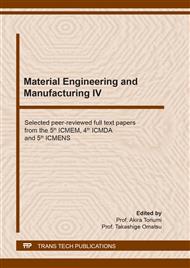[1]
M.D. Conci, A.C. Bozzi, A.R.F. Jr. Effect of plasma nitriding potential on tribological behaviour of AISI D2 cold-worked tool steel. Wear. Vol. 317 (2014), pp.188-193.
DOI: 10.1016/j.wear.2014.05.012
Google Scholar
[2]
Y. Luo, H. Jiang, G. Cheng G, et al. Effect of carburization on the mechanical properties of biomedical grade titanium alloys. J. Bionic. Eng. Vol. 8 (2011), pp.86-89.
DOI: 10.1016/s1672-6529(11)60004-8
Google Scholar
[3]
A.R. Mashreghi, S.M.Y. Soleimani, S. Saberifar. The investigation of wear and corrosion behavior of plasma nitrided DIN 1.2210 cold work tool steel. Mater. Des. Vol. 46 (2013), pp.532-538.
DOI: 10.1016/j.matdes.2012.10.046
Google Scholar
[4]
H.G. Nanesa, J. Boulgakoff, and M. Jahazi. Influence of prior cold deformation on microstructure evolution of AISI D2 tool steel after hardening heat treatment, J. Manuf. Processe. Vol. 22 (2016), pp.115-119.
DOI: 10.1016/j.jmapro.2016.02.002
Google Scholar
[5]
Y. Jian, Z. Huang, J. Xing, et al, Investigation on two-body abrasive wear behavior and mechanism of Fe-3.0 wt% B cast alloy with different chromium content. Wear. Vol. 2 (2016), pp.68-77.
DOI: 10.1016/j.wear.2016.04.029
Google Scholar
[6]
R. Carrera-Espinoza, U. Figueroa-López, J. Martínez-Trinidad, et al, Tribological behavior of borided AISI 1018 steel under linear reciprocating sliding conditions. Wear. Vol. 15 (2016), pp.1-7.
DOI: 10.1016/j.wear.2016.05.003
Google Scholar
[7]
M. Hansen, R. P. Elliott. Institute H T. Constitution of binary alloys. J. Electrocchem. Soc. Vol. 12 (1958), pp.1-260.
Google Scholar
[8]
H. L. Du, P. K. Datta, D. B. Lewis, et al, High-temperature corrosion of Ti and Ti-6Al-4V alloy. Oxid. Met. Vol. 45 (1996), pp.507-527.
DOI: 10.1007/bf01046849
Google Scholar
[9]
W. B. Xue, W. Chao, Y. L. Li, and et al, Characterization of microarc oxidation coatings on pure titanium. Rare Metals. Vol. 1 (2003), pp.113-116.
Google Scholar
[10]
A. Maytorena-Sánchez, L. García-González, L. Zamora-Peredo, et al, Microstructured Coating of TiO2 on Titanium Grade 2 Generated by Thermal Oxidation to Improve its Hardness. Microsc. Microanal. Vol. 26 (2020), pp.105-106.
DOI: 10.1017/s1431927620000756
Google Scholar
[11]
B. Sarma, N. Tikekar, K. Chandran, Kinetics of growth of superhard boride layers during solid state diffusion of boron into titanium. Ceram. Int. Vol. 38 (2012), pp.6795-6805.
DOI: 10.1016/j.ceramint.2012.05.077
Google Scholar
[12]
A. Voevodin, J. Zabinski, Super-tough wear-resistant coatings with chameleon,surface adaptation. Thin Solid Films. Vol. 370 (2000), pp.223-231.
DOI: 10.1016/s0040-6090(00)00917-2
Google Scholar


